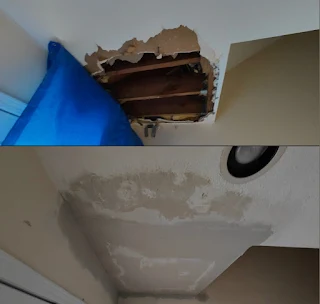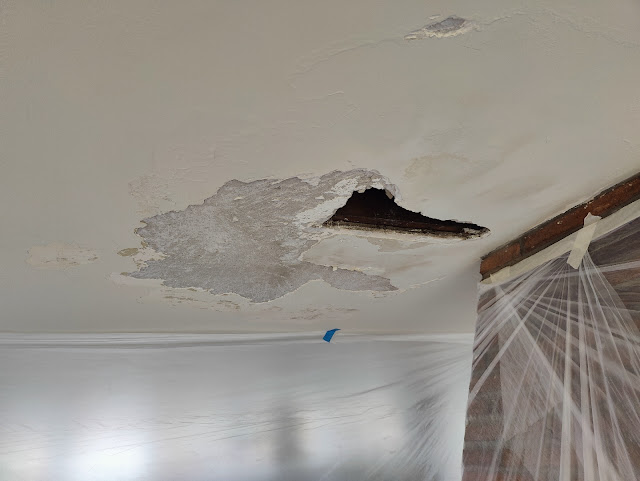Ceiling dripping? - Here is how to Limit Expensive Damage
First: Don't panic!
The most important thing you can do is gain control over the situation. That starts by poking a hole in the ceiling and letting the water out. Make sure you have a bucket, a trash can. The goal here is control where the water goes. You may not be able to stop the flow, but if you can control where that flow goes, you can minimize the damage.
Let the Water Out!
A screw driver works well, or in the case above- a tree branch! The ceiling is completely saturated, so creating a hole is easy. A small hole, is cheaper and easier to fix, than a big hole. Often times with water-damage, the drywall panel will warp necessitating replacement of a larger area, but you don't want to get into the level of demo right now. Small hole is all that is needed, or a bunch of small holes. I have personally removed over 6 gallons of water from a dripping ceiling by poking holes in it. This is something you can do yourself.If you don't have a ladder and can't reach the ceiling, a broom handle will work.
If you don't let the water out, depending on the source of the leak can lead to a ceiling collapse. Where the plaster or drywall detaches from the ceiling and falls to the floor. We have seen it happen (usually with plumbing leaks)
The longer the water is in the ceiling, the more damage it has the potential to cause.
Once the hole is created and the water is draining, take note of the water temperature. If its hot, its from the plumbing, if its ice cold, its probably from outside. Either way, as a precaution, turn off the water at the meter in the basement. Its a pipe sticking out of the wall, 4' or so below the ground. Maybe near the hot water tank and sump pump hole. If you live in a ranch house, chances are its not plumbing related.
Then make your frantic phone calls for help.
We can fix the ceiling, however we can not fix the leak.
Don't Demo Your Ceiling
The reason you don't want to open the ceiling is due to the construction of your home. Often times there is not much between the ceiling cavity and the outside. Depending on where the the roof line is over the ceiling, chances are, its a direct shot outside. The issue here is that a large hole, will cause a chimney effect and suck all the heat out of your house! You want small holes.
Also, pulling down drywall, is dirty, can be very messy. If its a plaster ceiling, you could have rockwool above the ceiling which is like loose cellulose. Its extremely messy and dirty. You do not want to contend with a giant mess on top of the water leak. If you plan to remove the damaged section of ceiling yourself, buy some painters plastic and cover everything in the vicinity, turn off the HVAC system - you don't want the furnace kicking on as you remove pieces of the ceiling and causing dust and dirt to blow through out your house! Then cut the drywall with a tool (Do NOT use a reciprocating saw or circular saw!!) A drywall saw works well. Don't attempt to pry the drywall off the ceiling, you could do even more damage, and depending on the size of the piece that breaks off, you could drop it causing irreparable damage to the floor!
If its a plaster ceiling, please don't get too creative. Plaster can weigh 10x as much as drywall, and its guaranteed to have 1/2" of dust dirt and grit, laying on the backside of the ceiling! Small holes.
Looks Can be Deceiving
Ceiling water damage often looks way worse than it actually is. However do not assume its not as bad as you think it is! A water leak into your home is an emergency! And needs to be handled with urgency. If its a roof leak, you need a roofer. If its a plumbing leak, you need a plumber or a handyman. A handyman may be able to put a bandaid on your roof issue if he can safely get to it.
Sometimes the source of the leak is apparent, most of the time its not. And just because the water is leaking into the dining room, doesn't mean the leak is above the dining room. Its likely somewhere else, and travelling along the framing and then dripping off at that point.
Ice dams are another source of water leaks. What happens is ice fills your gutters, snow starts to melt, and then the water has no where to go, so it backs up under your shingles. Its been 20 years since I have done roofing, but back then, we used to install 6' of a product called Ice and Water Shield. Think of a 3' wide roll of roofing shingle material, with a sticky side. This is applied to the edge of the roof directly onto the plywood sheathing from the drip edge up 6'. All valleys get Ice & Water Shield as well. The purpose is to prevent water infiltration from under the shingles.
Step 3: Get the leak fixed
Step 4: Call us (716-697-3560) to fix the wall or ceiling damage.




Comments
Post a Comment